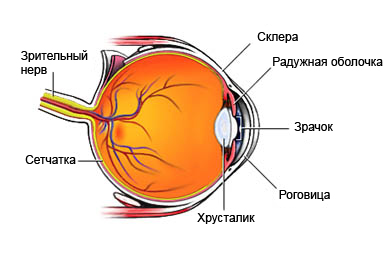Astigmatizm
Description of astigmatism
Astigmatizm – disease, where vision becomes blurry, not focused, Fuzzy, because the cornea (the front surface of the eye) or the lens, which is located corn, They have the wrong shape. Astigmatism can develop in children and adults. Astigmatism is a fairly common disorder and not contrast.
There are two common types of astigmatism: corneal astigmatism and crystal astigmatism.
- In corneal astigmatism sparkling cornea;
- Crystalline astigmatism occurs due to defects in the surface of the lens.
There are various methods of treating astigmatism. If there is a suspicion of a disease, you must consult a doctor.

The causes of astigmatism
The exact cause of astigmatism is unknown. It is often present at birth and can be combined with myopia or farsightedness. Sometimes astigmatism can occur after an injury or eye operation.
Risk factors of astigmatism
Factors, which increase the likelihood of astigmatism:
- Heredity – Family history of diseases or eye disorders, Such as keratoconus;
- Eye surgery – Some of the types of eye surgery, such as cataract removal;
- Rubing or thinning of the cornea;
- Excessive myopia (Visual defect, when distant objects seem blurry) Or farsightedness (Visual defect, where distant objects are better visible, than close ones).
Symptoms of astigmatism
Symptoms of astigmatism can be different in different people. In some people, the disease may occur as imperative. The above symptoms can be caused not only by astigmatism, and other serious illnesses. When they occur, seek medical advice.
- Dizziness;
- Headache;
- Blurry (Objects seem fuzzy) or distorted (objects are not in focus or have a distorted shape) sight;
- Excessive squint or eye closing.
Astigmatism diagnostics
The doctor asks about the symptoms and medical history, and performs a physical exam. For further examination, the patient may be sent to an ophthalmologist (eye disease).
Tests may include the following:
- Test assessment of visual acuity – This test is used to determine that, how well a person can distinguish letters or symbols of different sizes (From very large to very small) At a certain distance;
- Visual vision on the refractor – This test uses a refractor – special tool, which has interchangeable lenses of various strengths, to determine, how well the patient sees objects at various distances. You need to look through the lens and read the text or recognize images from a distance of several meters. The ophthalmologist regulates the strength of the lens based on the patient's answers;
- Keratoscope – The device is used to detect and measure the presence of curvature of the corneal surface.
Astigmatism treatment
Treatment options include the following:
Correcting lenses
Correcting lenses, Such as glasses or contact lenses are designed to compensate for visual anomalies or eye defects, Such as myopia, farsightedness or astigmatism.
Operation
To adjust severe astigmatism, an ophthalmologist can use special knives or laser beam, To correct an abnormal or cornea curve. Correction operation – The outpatient procedure (does not require stay in the hospital), which is performed under local anesthesia.
There are several types of surgical procedures, which can perform an ophthalmologist:
- Photo refractive keratectomy (FRK) – To change the shape of an abnormal or curved cornea, a laser beam is used;
- Laser adjustment of keratomilesis – To perform the operation of an ophthalmologist uses a laser beam. To change the shape of a curved cornea, Her extra fabric is removed;
- Radical keratotomy (RK) – Small cuts are made in the cornea (cuts), which, when healing, change its shape and refractive force;
- Subopithelial keratomilesis of laser help – This procedure is not used often, However, it has additional advantages, especially for patients with a thin cornea or with a high risk of eye damage.
Profilactics of astigmatism
At the moment, there are no methods for the prevention of astigmatism, However, regular examinations of an ophthalmologist allow you to identify the disease in time and take appropriate measures.
